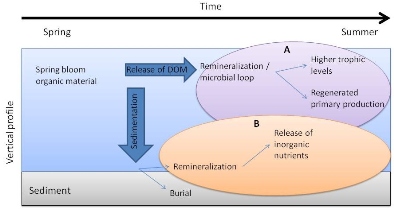Summary
The spring bloom in the Baltic Sea, as in most temperate aquatic systems, is by far the most important phase of the annual succession in terms of primary production as typically 40 to 60% of the annual carbon fixation takes place during a few weeks. Two phytoplankton groups are predominant during spring in the Baltic Sea: diatoms and dinoflagellates. The relative abundances of these algal groups have a large effect on remineralization, or biogeochemical flux of the spring biomass. Diatoms settle quickly to the sea floor whereas dinoflagellates either lyse before reaching the sediment or produce resistant resting cysts that is not degraded in the sediment. The dominance by either phytoplankton group thus affects directly both the summertime nutrient pools of the water column, and the input of organic matter to the bottom sediments, to contrasting directions. In parts of the Baltic Sea, dinoflagellates are getting more abundant at the expense of diatoms. What effect this change in phytoplankton community composition will have on biogeochemical fluxes is currently not known, as most previous research has focused on sediment interactions for understanding biogeochemical fluxes.
The main objective of the proposed study is twofold:
1) To determine what changes in spring bloom phytoplankton community has on flux of organic matter in the pelagic system.
2) Apply these findings in a state of the art ecosystem model, which will be used to better understand how changes in the phytoplankton community affects biogeochemical fluxes.

A conceptual model of the fate of organic material produced during spring bloom. Over the last decades dinoflagellates have grown more dominant during the spring bloom at the expense of diatoms. One of the hypothesis tested in this project is that this leads to a shift in remineralization of the organic material from pathway B towards pathway A.
More information
Dr. Kristian Spilling, Finnish Environment Institute SYKE,
firstname.surname@ymparisto.fi